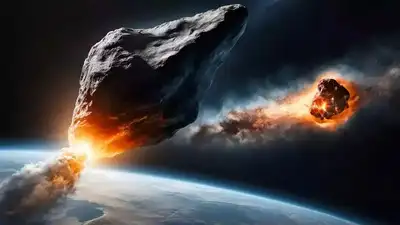
Earth is continuously at risk from potential hazards in space, and perhaps the most dreaded are near-Earth asteroids—space objects with orbits bringing them close to the planet in threatening proximity. While most pass harmlessly by, each near-flyby serves as a sobering reminder of Earth's exposure. A near-Earth asteroid, namely
asteroid 2025 HY2
, has just caught significant attention from scientists and space agencies all over the world.
Its upcoming flyby calls to mind the ongoing need for caution, improved detection capabilities, and global cooperation to protect our world from potentially one day being a disastrous impact event.
Asteroid 2025 HY2 to pass Earth: Date, time and speed
Asteroid 2025 HY2 ought to be near its Earth-closing point on May 7, 2025, at 12:49 PM IST (07:19 UTC). It will be flying by at a remarkable velocity of approximately 48,904 kilometres per hour (approximately 30,389 miles per hour) when nearest to flyby.Though close and fast, the asteroid will fly by Earth by a mere 6.8 million kilometres (4.2 million miles). Though this sounds like a huge distance, by cosmic standards, it's a close call.
Understanding Apollo-class asteroids
Asteroid 2025 HY2 is an Apollo-class asteroid, a class of asteroids with orbits that cross Earth. They circle the Sun but cross Earth's orbit, and as such, they are of particular interest to planetary defense research.Apollo-class asteroids are some of the most tightly monitored near-Earth objects (NEOs). Even though nothing is threatened in the near term, orbits are adjusted by the action of gravity or solar radiation pressure over geological time scales and formerly harmless rocks in space can become threats.
How scientists worldwide work to predict space threats
Space agencies like NASA and the European Space Agency (ESA), in association with global observatories, work around the clock to monitor and evaluate the threats from these objects. The Center for Near-Earth Object Studies (CNEOS) and the Minor Planet Center gather and analyze information from a global network of professional and amateur astronomers.Through this collaborative effort, scientists can accurately predict asteroid orbits, enhance orbital simulations, and provide warning in advance of predicted collisions. But despite all these advances, the majority of small- to medium-sized asteroids are not found until near Earth.
What if asteroid 2025 HY2 had hit Earth
While 2025 HY2 is not a "potentially hazardous asteroid" (a designation reserved for those that are larger than 140 meters in diameter), it is big enough-about 120 feet (37 meters) in diameter, the size of a Boeing 737.If it were to enter the Earth's atmosphere, the effect would be catastrophic. To give an example, the Chelyabinsk meteor that detonated in the air over Russia in 2013 was only 59 feet (18 meters) in diameter. But it hurt more than 1,500 people, broke thousands of buildings, and caused indiscriminate panic from a shockwave.A 2025 HY2 crash that is twice the magnitude of the 2013 crash can wipe out city blocks a few kilometres from ground zero.
- Produce shockwaves that ought to shatter windows and topple buildings
- Induce fires or local earthquakes depending on where it hits
- Involve enormous casualties, especially in cities
Growing risk of undiscovered asteroids
Asteroid 2025 HY2 is not the threat this time, but the close flyby is a hair-raising reminder. There are thousands of such asteroids that are yet to be discovered in our solar system, and the warning margin can be very narrow.This advancement of early warning systems, planetary defense missions, and even technology to deflect an asteroid is global. NASA's DART mission-Double Asteroid Redirection Test, for example, was a historic benchmark demonstrating our ability to push the asteroid off its course.Yet, as these objects make their way quietly towards our planet, disaster lurks around the corner. Asteroid 2025 HY2 is merely the newest in a never-ending rotation of reminders that defending the world isn't science fiction—it's real-life insurance against extinction.Also Read | What is the ‘Black Hole Bomb’ theory and how scientists brought it to life in the lab

 1 month ago
189
1 month ago
189




























 English (US)
English (US)